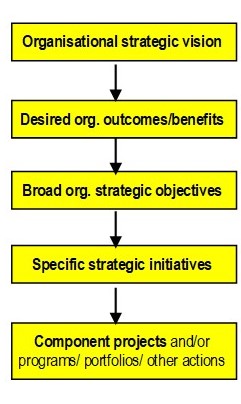and responsibilities for benefits realization
FEATURED PAPER
By Alan Stretton, PhD (Hon)
Sydney, Australia
INTRODUCTION
The project management literature can be somewhat confusing in the way it depicts relationships between the project/program management (PPM) components of organisational strategic initiatives, and PPM involvement (or lack of involvement) in facilitating the achievement of broader strategic outcomes, and particularly in the realisation of benefits that (hopefully) flow from these. For example, there are at least three quite different depictions of responsibilities for benefits realisation management (BRM):
- Project and/or program management (PPM), and particularly the latter, are depicted as responsible for benefits management and/or its realization (e.g. “program benefits management”);
- The users of project/program outputs are seen as responsible for benefits realisation management (BRM), with PPM involvement in the latter varying from nil to very substantial;
- The focus is on the utility of project/program deliverables, with no direct consideration of broader benefits.
Such differences are obviously related to the large number of different contexts in which strategic initiatives, and their component projects/programs, are undertaken, and the even larger numbers of types of such initiatives, and of possible benefits relating to them. However, proponents of specific depictions of BRM responsibilities rarely, if ever, discuss whether or not these are appropriate to other contexts. This tends to leave an impression (hopefully unintended) that their particular depiction applies either universally, or very widely. If this impression is correct, it is highly misleading, and appears to warrant a more detailed analysis.
I have not seen any relevant analyses that relate different depictions of responsibilities for benefits realisation management with different types of strategic initiatives. This article attempts to rectify this situation. However, as will be seen, it is essentially only exploratory. Whilst it attempts a broad coverage of types of strategic initiatives and BRM responsibilities, it is far from being comprehensive. However, it is a start, and hopefully may encourage others to expand this topic further.
In this article I have mainly tried to represent the perspective of the owners/users of the outputs from strategic initiatives and their component projects/programs, rather than that of either internal or external resources which deliver these outputs.
SOME BACKGROUND ON STRATEGIC BENEFITS & PROJECTS/PROGRAMS
From strategic vision, to desired outcomes/benefits, to broad strategic objectives, to specific strategic initiatives, to component projects/programs.
The above sequence, which helps illustrate basic relationships between projects/ programs/ portfolios and strategic benefits, follows that outlined by Abba et al 2018:
Strategies in fact should flow from desired outcomes and benefits; programs and projects then flow from strategies to achieve those benefits.
 The sequence generally starts with a vision statement, which Ingason & Jonasson 2019 describe as “creating a clear vision for future direction that entails clear goals”.
The sequence generally starts with a vision statement, which Ingason & Jonasson 2019 describe as “creating a clear vision for future direction that entails clear goals”.
These goals are expressed by Abba et al 2018 as “desired outcomes and benefits”. These are then developed and shaped into broad organisational strategic objectives.
Specific strategic initiatives are then developed to achieve specific outcomes and benefits from these broad objectives.
Strategic initiatives are described by Cooke-Davies 2016 as comprising projects, and/or programs, portfolios, and other actions (which I have described as other strategic work).
In this article we will be primarily concerned with activities following this sequence, how projects, programs, portfolios, and other strategic work, contribute to the realisation of ensuing benefits, and responsibilities for the BRM.
A basic organizational strategic management framework
The above sequence, and its continuation, are broadly reflected in the following basic organizational strategic management framework, which I have been using for some time. We will be mainly concerned with Stages 4 and 5, and particularly with responsibilities for the realisation of benefits from the strategic initiatives.

Figure 1: A basic organizational strategic management framework
TOWARDS A CATEGORISATION OF STRATEGIC INITIATIVES AND BENEFITS
The multiplicity of possible strategic initiatives and benefits
As noted in the introduction, there are some very different representations in the project management literature about the nature and extent of PPM involvement in BRM, and these undoubtedly reflect the very different types of possible strategic initiatives, and ensuing benefits. The latter is emphasised in PMI 2017 in its introductory section in Ch 4. Program Benefits Management:
Various types of benefits may be defined and generated by programs. Some benefits, such as expanded market presence, improved financial performance, or operational efficiencies, may be realized by the sponsoring organization while other program outcomes may be realized as benefits by the organization’s customers or the program’s intended beneficiaries.
With such a multiplicity of possible strategic benefits, the challenge is to find a reasonable number of groups of such benefits that share sufficient common ground to provide a basis for discussion and analysis – particularly about responsibilities for realizing the ultimate benefits, which is the main concern of this article.
The following discussions track my attempts to develop a categorisation of strategic initiatives and benefits. This started with a partial categorisation by Shenhar & Dvir
A strategic portfolio classification framework – Shenhar & Dvir 2004
Shenhar & Dvir 2004 developed a strategic portfolio classification framework “based on the need to select projects in accordance with their strategic impact”.
….[Shenhar & Dvir] identified two dimensions to divide projects: the strategic goal dimension, which included operational and strategic projects, and the customer dimension, which involves external and internal customers … This results in four major groups of projects …
This framework is shown in Figure 2, together with the authors’ examples of types of projects which would fall into each of the four major groups

Figure 2: Based on Shenhar & Dvir 2004 – Table 50.2: Strategic portfolio classification
It can be seen that Shenhar & Dvir share the distinction made by PMI in the earlier quotation above between internal and external customers or beneficiaries.
More…
To read entire article, click here
How to cite this paper: Stretton, A. (2020). Strategic initiatives, project/program management, and responsibilities for benefits realization; PM World Journal, Volume IX, Issue V, May. Available online at https://pmworldlibrary.net/wp-content/uploads/2020/05/pmwj93-May2020-Stretton-Strategic-initiatives-PPM-and-BRM-responsibilities.pdf
About the Author

Alan Stretton, PhD
Faculty Corps, University of Management
and Technology, Arlington, VA (USA)
Life Fellow, AIPM (Australia)
![]()
Alan Stretton is one of the pioneers of modern project management. He is currently a member of the Faculty Corps for the University of Management & Technology (UMT), USA. In 2006 he retired from a position as Adjunct Professor of Project Management in the Faculty of Design, Architecture and Building at the University of Technology, Sydney (UTS), Australia, which he joined in 1988 to develop and deliver a Master of Project Management program. Prior to joining UTS, Mr. Stretton worked in the building and construction industries in Australia, New Zealand and the USA for some 38 years, which included the project management of construction, R&D, introduction of information and control systems, internal management education programs and organizational change projects. He has degrees in Civil Engineering (BE, Tasmania) and Mathematics (MA, Oxford), and an honorary PhD in strategy, programme and project management (ESC, Lille, France). Alan was Chairman of the Standards (PMBOK) Committee of the Project Management Institute (PMI®) from late 1989 to early 1992. He held a similar position with the Australian Institute of Project Management (AIPM), and was elected a Life Fellow of AIPM in 1996. He was a member of the Core Working Group in the development of the Australian National Competency Standards for Project Management. He has published over 200 professional articles and papers. Alan can be contacted at alanailene@bigpond.com.au.
To see more works by Alan Stretton, visit his author showcase in the PM World Library at http://pmworldlibrary.net/authors/alan-stretton/.









